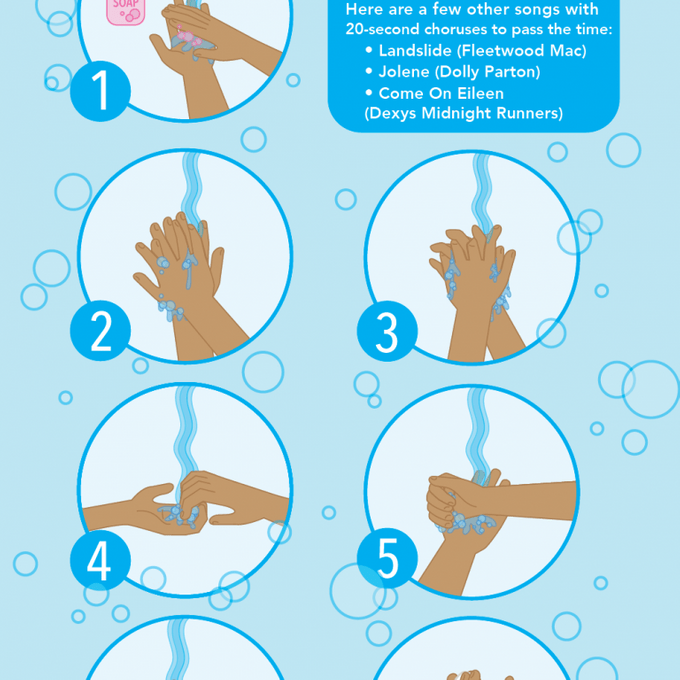Turn on the faucet and grab some soap. You're going to want to practice this.

How to Wash Your Hands the Right Way

A good sudsy scrub in the sink is your power move against harmful germs. The reason? According to the U.S. Centers for Disease Control and Prevention (CDC), most people touch their eyes, mouth or nose about 25 times every hour without even noticing. Think about all the doorknobs, children’s toys, pets or even raw chicken you’ve touched in the last 60 minutes. Yikes.
Of course, your mom probably taught you how to wash your hands. But since then, experts have found the best hand-washing technique to keep you and yours healthy.
How to Wash Your Hands the Correct Way
The World Health Organization published a report on hand hygiene that’s 262 pages long! Here’s the hand-washing technique it recommends to get your hands squeaky clean:

- Soap up, then rub palms together.
- Place right palm on the back of left hand. Interlace fingers, and rub to clean edges of fingers. Switch hands and repeat.
- Place palms together. Interlace fingers and rub to clean edges of fingers.
- Make a C shape with both hands. Interlock the Cs. Rub back and forth to clean tops of fingers.
- Hold left thumb with right palm. Rotate right hand to clean thumb. Switch hands and repeat.
- Open left palm. Rub right fingernails back and forth in a circular motion to clean fingernails. Switch hands and repeat.
- Rinse hands with water, then dry completely with a towel. If possible, use a towel to turn off the faucet.
Did you follow along at your desk? We thought so. The CDC recommends scrubbing hands for at least 20 seconds, which coincidentally happens to be the same as singing the “Happy Birthday” song twice. Here are some other songs with 20-second choruses to help pass the time:
- “Come On Eileen” (Dexy’s Mightnight Runners)
- “Landslide” (Fleetwood Mac)
- “Jolene” (Dolly Parton)
Even with squeaky-clean fingers, however, it’s important to follow a few basic guidelines when handling food in the kitchen. Our Test Kitchen experts share their best tips for keeping the kitchen clean.
Taste of Home Test Kitchen Tips for Clean Meal Prep
- Always wash your hands. Follow the technique listed above before preparing your food. Be sure to rewash them if you stop to do a task such as texting or shuffling through your cookbooks.
- Use a liquid soap dispenser. Hands-free soap dispensers let you get sudsy without contaminating anything else. If you don’t have one, be sure to clean your soap dispenser periodically.
- Remove rings and bracelets. This is especially a must when you’re kneading dough or mixing raw meat. Jewelry can be difficult to clean and, much like hands, it can harbor bacteria.
- Set up your workspace before you pull out raw meat. You don’t want to be opening cabinets, reaching into drawers and looking for ingredients with contaminated hands. Pull out the salt and pepper, make your marinade and get out your roasting pan and utensils before you start. Also, clear out your sink so any draining food or dishes aren’t contaminated when you wash your hands.
- Use one hand or tools to handle raw meat. If you can, dirty only one hand, so you can use your clean hand to season food, light the stove or turn on the faucet. Use tongs to transfer raw meat to a grill or skillet. If you’re handling raw meat where there’s no running water nearby (backyard, picnic, tailgating), wear disposable gloves—just be sure to take them off before you finish the rest of your prep.
- Get creative if both hands are dirty. After handling raw meat, turn on the faucet and pump your soap dispenser using your wrist, forearm or the back of your hand. If your hands are greasy from tossing veggies with oil or shaping meatballs, try wiping your hands with paper towels before washing up. And clean your sink before using it to drain cooked pasta or wash vegetables.
- Dry your hands thoroughly. Wet hands transfer bacteria more easily than dry hands. If you’ve handled raw meat, it’s probably best to dry your hands with a paper towel. In general, change hand towels often. Bacteria can flourish in a damp towel.
Armed with these tips, you can keep your home cleaner, fresher and safer than ever. Staying healthy feels good, doesn’t it?



















